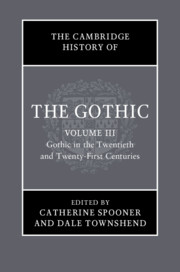Book contents
- The Cambridge History of the Gothic
- The Cambridge History of the Gothic
- The Cambridge History of the Gothic
- Copyright page
- Contents
- Figures
- Notes on Contributors
- Acknowledgements
- Introduction: A History of Gothic Studies in the Twentieth and Twenty-First Centuries
- 3.1 Gothic and Silent Cinema
- 3.2 Gothic, the Great War and the Rise of Modernism, 1910‒1936
- 3.3 Gothic and the American South, 1919‒1962
- 3.4 Hollywood Gothic, 1930–1960
- 3.5 Gothic and War, 1930‒1991
- 3.6 Gothic and the Postcolonial Moment
- 3.7 Gothic and the Heritage Movement in the Twentieth and Twenty-First Centuries
- 3.8 Gothic Enchantment: The Magical Strain in Twentieth and Twenty-First-Century Anglo-American Gothic
- 3.9 Psychoanalysis and the American Popular Gothic, 1954–1980
- 3.10 Gothic and the Counterculture, 1958‒Present
- 3.11 Gothic Television
- 3.12 Gothic and the Rise of Feminism
- 3.13 Gothic, AIDS and Sexuality, 1981–Present
- 3.14 The Gothic in the Age of Neo-Liberalism, 1990‒Present
- 3.15 The Gothic and Remix Culture
- 3.16 Postdigital Gothic
- 3.17 Gothic Multiculturalism
- 3.18 Gothic, Neo-Imperialism and the War on Terror
- 3.19 Global Gothic 1: Islamic Gothic
- 3.20 Global Gothic 2: East Asian Gothic
- 3.21 Global Gothic 3: Gothic in Modern Scandinavia
- 3.22 Gothic in an Age of Environmental Crisis
- 3.23 Gothic and the Apocalyptic Imagination
- Select Bibliography and Filmography
- Index
3.21 - Global Gothic 3: Gothic in Modern Scandinavia
Published online by Cambridge University Press: 29 July 2021
- The Cambridge History of the Gothic
- The Cambridge History of the Gothic
- The Cambridge History of the Gothic
- Copyright page
- Contents
- Figures
- Notes on Contributors
- Acknowledgements
- Introduction: A History of Gothic Studies in the Twentieth and Twenty-First Centuries
- 3.1 Gothic and Silent Cinema
- 3.2 Gothic, the Great War and the Rise of Modernism, 1910‒1936
- 3.3 Gothic and the American South, 1919‒1962
- 3.4 Hollywood Gothic, 1930–1960
- 3.5 Gothic and War, 1930‒1991
- 3.6 Gothic and the Postcolonial Moment
- 3.7 Gothic and the Heritage Movement in the Twentieth and Twenty-First Centuries
- 3.8 Gothic Enchantment: The Magical Strain in Twentieth and Twenty-First-Century Anglo-American Gothic
- 3.9 Psychoanalysis and the American Popular Gothic, 1954–1980
- 3.10 Gothic and the Counterculture, 1958‒Present
- 3.11 Gothic Television
- 3.12 Gothic and the Rise of Feminism
- 3.13 Gothic, AIDS and Sexuality, 1981–Present
- 3.14 The Gothic in the Age of Neo-Liberalism, 1990‒Present
- 3.15 The Gothic and Remix Culture
- 3.16 Postdigital Gothic
- 3.17 Gothic Multiculturalism
- 3.18 Gothic, Neo-Imperialism and the War on Terror
- 3.19 Global Gothic 1: Islamic Gothic
- 3.20 Global Gothic 2: East Asian Gothic
- 3.21 Global Gothic 3: Gothic in Modern Scandinavia
- 3.22 Gothic in an Age of Environmental Crisis
- 3.23 Gothic and the Apocalyptic Imagination
- Select Bibliography and Filmography
- Index
Summary
Since the millennium, there has been a boom in Gothic stories in the Scandinavian countries. Many of them have received global attention, such as John Ajvide Lindqvist’s vampire novel Let the Right One in (2004), which has been adapted into two films, one Swedish-language film and one American version. This chapter addresses the historical and cultural context for this contemporary outburst of Gothic stories in the Scandinavian countries. It also presents some possible prerequisites for its international success. First, the chapter provides a survey of Gothic fiction in the Nordic countries, from its beginning in the nineteenth century up to the present. It demonstrates how Scandinavian Gothic is densely intertextual at the same time as it makes visible political and ecological anxieties central for the understanding of Scandinavian identities and ideologies. It also emphasises the use of Nordic settings and local folklore. Second, the mode expands on three distinct Gothic categories in Scandinavian narratives: the use of local popular believes in today’s crossover and Young Adult stories, the Gothic qualities of the Scandinavian landscape and its mythic creatures, and the rise of certain Gothic hybrid genres, such as Gothic crime.
Keywords
- Type
- Chapter
- Information
- The Cambridge History of the GothicVolume 3: Gothic in the Twentieth and Twenty-First Centuries, pp. 424 - 443Publisher: Cambridge University PressPrint publication year: 2021

